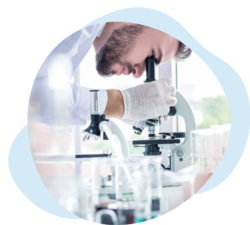It is well known that bacteria and fungi hide various metabolites related to their pathogenesis. However, the effect of these metabolites on microbial virulence is poorly understood.
One well-known example of a metabolite is a quorum sensing molecule that allows microbes to share information about cell density and adjust gene expression. It allows organisms to modulate pathogenic processes, thus increasing virulence. Therefore, understanding the metabolome associated with the microbiome is an integral part of providing a complete picture of the microbial landscape.
NTS can assess the metabolome associated with microbiome analysis (tissue, stool, or culture models) and determine the identification of bacterial or fungal metabolites. Samples can be extracted in solution with internal standards and lyophilized. The technological approach allows for identification of metabolites, which includes amino acids, nucleotides, fatty acids, etc. and can be quantitatively observed using multiple reaction monitoring. Appropriate statistical measures are then applied to the data to identify metabolites that are significantly altered in each comparison.

NTS has an established relationship with the Department of Pharmacology at Case Western Reserve University and Dr. Masaru Miyagi.
NTS has an established relationship with the Department of Pharmacology at Case Western Reserve University and Dr. Masaru Miyagi, a dedicated expert in metabolomics and proteomics. The relationship enables the company to dive deeper into microbial metabolomics. Dr. Miyagi is an expert in mass spectrometry and application of mass spectrometry-based methodologies for proteome and metabolome analyses.
Related Articles
-
Alcohol Dehydrogenase Restricts the Ability of the Pathogen Candida Albicans to Form a Biofilm on Catheter Surfaces Through an Ethanol-based Mechanism
Candida biofilms formed on indwelling medical devices are increasingly associated with severe infections. In this study, we used proteomics and Western and Northern blotting analyses to demonstrate that alcohol dehydrogenase (ADH) is downregulated in Candida biofilms. Disruption of ADH1 significantly (P = 0.0046) enhanced the ability of Candida albicans to form biofilm.
-
Metabolomics Reveals Differential Levels of Oral Metabolites in Hiv-infected Patients: Toward Novel Diagnostic Targets
The objective of the current study was to characterize the profile of oral metabolites in HIV-infected patients using metabolomics. Oral wash samples were collected from 12 HIV-infected and 12 healthy individuals (matched for age, sex, and ethnicity), processed, and analyzed by metabolomics.
-
Metabolomic Analysis Identifies Differentially Produced Oral Metabolites, Including the Oncometabolite 2-hydroxyglutarate, in Patients with Head and Neck Squamous Cell Carcinoma
Metabolomics represents a promising approach for discovering novel targets and biomarkers in head and neck squamous cell carcinoma (HNSCC). Here we used metabolomics to identify oral metabolites associated with HNSCC.
-
Effects of a Novel Probiotic Combination on Pathogenic Bacterial-Fungal Polymicrobial Biofilms
Dysbiosis of the gut microbiome has been implicated in inflammatory bowel diseases. We have shown that levels of Candida tropicalis, along with those of Escherichia coli and Serratia marcescens, are significantly elevated in Crohn’s disease (CD) patients. Here, we evaluated the ability of a novel probiotic to prevent and treat polymicrobial biofilms (PMB) formed by C. tropicalis with E. coli and S. marcescens